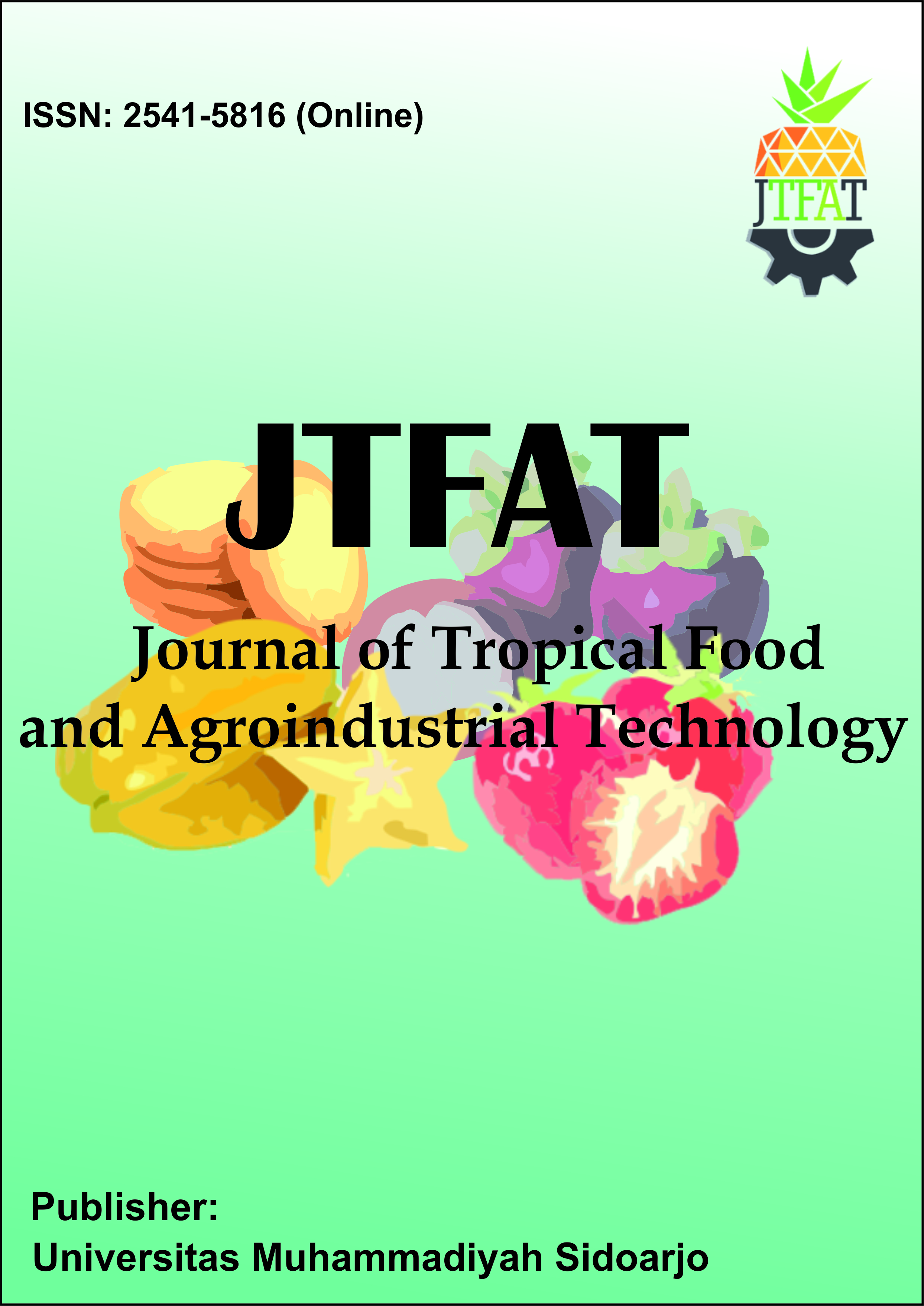Physical Characteristics of Tofu Dregs Flour as a Functional Food Ingredient
Tofu Dregs Flour
DOI:
https://doi.org/10.21070/jtfat.v7i01.1654Keywords:
tofu dregs flour, functional foodAbstract
Tofu dreg flour is a processed product derived from wet tofu residue, which is dried either by direct sunlight or using a mechanical dryer. Before a material can be utilized as a food ingredient, its physical properties and characteristics must first be understood to determine the appropriate direction for its potential application in food development. This study aims to characterize the physical properties of soybean dreg flour, including color analysis, bulk density, water and oil absorption capacity, and flour morphology. Data analysis was conducted descriptively using a quantitative approach. The physical analysis of the soybean dreg flour showed the following results: color values of a* 2.9, b* 17.6, L* 79.6, chroma (C*) 17.8, and hue angle (h°) 80.7. The bulk density was recorded at 1.83 g/mL. The water absorption capacity was 8.00 g/g (dry basis), and the oil absorption capacity was 2.80 g/g (dry basis). Morphological observations indicated the presence of protein bodies and fibers, with no starch granules detected in the flour. In conclusion, soybean dreg flour exhibits physical characteristics that suggest its potential application as a functional food substitute in the future.
References
Abduh, S.B.M., Nurwantoro, Mulyani, S., Nurwidiyanto, A.R. and Widiyanti, S.H. (2024). Gelatinization Behavior, Morphological, and Chemical Properties of Flour of Cassava, Sago, and Whea. ASEAN Journal of Chemical Engineering, 24(3) : 260–275. https://doi.org/10.22146/ajche.12187.
Andriani, R., Nurlila, R.U., Surianto, T., Srtudi, P., Farmasi, S., Sains, F., Mandala, U., Keperawatan, P.S., Kesehatan, F.I. and Waluya, U.M. (2025). Edukasi Pangan Fungsional Berbasis Pangan Lokal dan Pemilihan Kosmetik yang Baik di Kelurahan Nambo Kota Kendari. 6(1) : 197–202.
Balet, S., Guelpa, A., Fox, G. and Manley, M. (2019). Rapid Visco Analyser ( RVA ) as a Tool for Measuring Starch-Related Physiochemical Properties in Cereals : a Review. https://doi.org/10.1007/s12161-019-01581-w.
Devi, L.M. and Badwaik, L.S. (2022). Variety difference in physico-chemical, cooking, textural, pasting and phytochemical properties of pigmented rice. Food Chemistry Advances, 1 : 100059. https://doi.org/10.1016/j.focha.2022.100059.
Fidyasari, A., Estiasih, T., Wulan, S.N. and Khatib, A. (2024). The physicochemical, functional, and pasting properties of Moringa oleifera leaf powder from different leaf stalk colors’. CYTA - Journal of Food, 22(1). https://doi.org/10.1080/19476337.2024.2402062.
Hasmadi, M. (2021). Effect of Water on The Caking Properties of Different Types of Wheat Flour. Food Research, 5(1) : 266–270.: https://doi.org/10.26656/fr.2017.5(1).412.
Istiqomah, A. (2022) . Pengaruh Penambahan Bekatul terhadap Sifat Fisikokimia dan Sensoris pada Donat Vegetarian. Jurnal Teknologi Pangan, 6(1) : 1–7. https://doi.org/10.14710/jtp.2022.30266.
Khan, M.A.I., Ueno, K., Horimoto, S., Komai, F., Tanaka, K. and Ono, Y. (2009). Physicochemical, Including Spectroscopic, and Biological Analyses During Composting of Green Tea Waste and Rice Bran. Biology and Fertility of Soils, 45(3) :305–313. https://doi.org/10.1007/s00374-008-0335-x.
Kurniasari, N.I. and Wibisono, Y. (2023). Penambahan Tepung Ampas Tahu dan Tepung Kulit Buah Naga Terhadap Tepung Premiks Pancake. JOFE: Journal of Food Engineering, 2(2) :73–77. http://dx.doi.org/10.25047/jofe.v2i2.3456%0Ahttps://publikasi.polije.ac.id/index.php/jofe/article/download/3456/2228.
Maulida Majid, S. and Farida, E. (2022). Formulasi Snack Bar Berbahan Dasar Tepung Kedelai (Glycine max L.) dan Tepung Labu Kuning (Cucurbita moschata Durch) Sebagai Makanan Alternatif Sumber Energi Syahrina. Indonesian Journal of Public Health and Nutrition, 4(2) : 217–224.
Nadhira, R. and Cahyana, Y. (2023). Kajian Sifat Fungsional dan Amilografi Pati dengan Penambahan Senyawa Fenolik ( Review ) Functional and Pasting Properties of Starch with Phenolic Compound Addition : Review. Jurnal Penelitian Pangan, 3(1) : 14–19.
Njintang, Y.N. and Mbofung, C.M.F. (2006).Effect of Precooking Time And Drying Temperature On The Physico-Chemical Characteristics and In-Vitro Carbohydrate Digestibility of Taro Flour. Lwt, 39(6) : 684–691. https://doi.org/10.1016/j.lwt.2005.03.022.
Nurdin, A., Setiasih, I.S., Djali, M. (2018). Pengaruh Pengeringan Ampas Tahu Terhadap Karakteristik Fisik dan Kimia Tepung Ampas Tahu. 2.
Okekunle, M.O., Adebowale, K.O., Olu-Owolabi, B.I. and Lamprecht, A. (2020). Physicochemical, morphological and thermal properties of oxidized starches from Lima bean (Phaseolus lunatus). Scientific African. https://doi.org/10.1016/j.sciaf.2020.e00432.
Qin, J., Xiao, M., Wang, S., Peng, C., Wu, X. and Jiang, F. (2023). Effect of Drying Temperature on Microstructural, Mechanical, and Water Barrier Properties of Konjac Glucomannan/Agar Film Produced at Industrial Scale. Lwt, 173 : 114275: https://doi.org/10.1016/j.lwt.2022.114275.
Rahayu, L.H., Sudrajat, R.W. and Rinihapsari, E. (2016). Teknologi Pembuatan Tepung Ampas Tahu Untuk Produksi Aneka Makanan Bagi Ibu-Ibu Rumah Tangga Di Kelurahan Gunungpati. Semarang’, E-Dimas, 7(1) : 68: https://doi.org/10.26877/e-dimas.v7i1.1040.
Ria Sarjono, P. and Iswantini, D. (2004). Pengembangan Metode Penentuan Isoflavon Kadar Rendah Dalam Limbah Cair Tahu Menggunakan Enzim Nadh Oksidase Determination of Isoflavones From Tofu Waste Using Nadh Oxidase Enzyme Methode. Sains & Apl, 7(1) : 17–21.
Septya, P., Chaniago, N., Priyono, S., Saputri, N.E., Studi, P., Pangan, T. and Pontianak, U.T. (2025). Pemanfaatan Tepung Ampas Tahu dengan Penambahan Pasta Kacang Merah dalam Formulasi Snackbar. 2.
Syafutri, M.I., Syaiful, F., Lidiasari, E. and Pusvita, D. (2020). Pengaruh Lama dan Suhu Pengeringan Terhadap Karakteristik Fisikokimia Tepung Beras Merah (Oryza nivara). AGROSAINSTEK: Jurnal Ilmu dan Teknologi Pertanian, 4(2) : 103–111. https://doi.org/10.33019/agrosainstek.v4i2.120.
Tong, C., Wu, Z., Sun, J., Lin, L., Wang, L., Guo, Y., Huang, Z., Wu, C. and Pang, J. (2020). Effect of Carboxylation Cellulose Nanocrystal and Grape Peel Extracts on The Physical, Mechanical and Antioxidant Properties of Konjac Glucomannan Films. International Journal of Biological Macromolecules, 156 :874–884. https://doi.org/10.1016/j.ijbiomac.2020.04.051.
Wati, F.H., Azhari, D., Darius, D. and Afriani, R. (2024). Substitusi Tepung Ampas Tahu Pada Pengolahan Kue Bay Tat. Student Research Journal, 2(1) : 165–178.
Downloads
Published
How to Cite
License
Copyright (c) 2025 Fidyasari Ambar, Hanum Zalzabilah, J Nelson Abimanyu

This work is licensed under a Creative Commons Attribution 4.0 International License.






